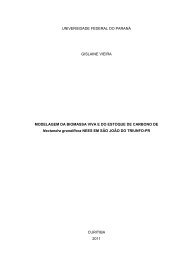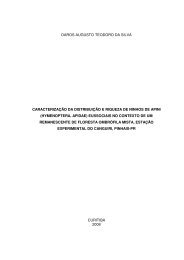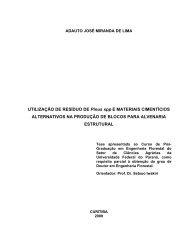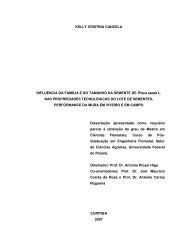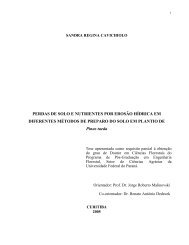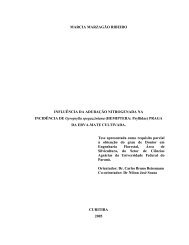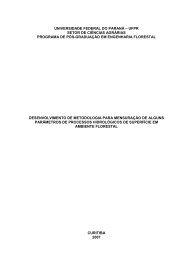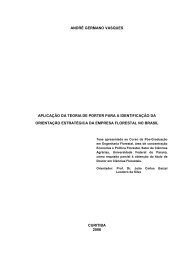Tese em PDF - departamento de engenharia florestal - ufpr ...
Tese em PDF - departamento de engenharia florestal - ufpr ...
Tese em PDF - departamento de engenharia florestal - ufpr ...
Create successful ePaper yourself
Turn your PDF publications into a flip-book with our unique Google optimized e-Paper software.
CAPÍTULO 1<br />
VARIAÇÕES GEO-PEDOLÓGICAS E PADRÕES ECOLÓGICOS DA VEGETAÇÃO<br />
ARBÓREA DE UM SEGMENTO DE ENCOSTA E DE PLANÍCIE DO BAIXO RIO<br />
JACUÍ, RS<br />
RESUMO<br />
Fragmentos <strong>de</strong> Floresta Estacional Decidual Aluvial e Submontana estudadas<br />
encontram-se ao longo <strong>de</strong> um gradiente com uma gran<strong>de</strong> variação geomorfológica e<br />
pedológica. Assim, para enten<strong>de</strong>r a composição florística e suas similarida<strong>de</strong>s<br />
nesses ambientes, foram estudadas <strong>de</strong> forma <strong>de</strong>talhada as condições <strong>de</strong> solos e as<br />
formas <strong>de</strong> relevo presentes <strong>em</strong> uma microbacia <strong>de</strong> geologia sedimentar do rio Jacuí,<br />
no município <strong>de</strong> Pantano Gran<strong>de</strong>, Rio Gran<strong>de</strong> do Sul. Para levantar essas variáveis<br />
foram instaladas 200 parcelas <strong>de</strong> 100 m² distribuídas <strong>em</strong> 40 pontos amostrais com 5<br />
parcelas cada, <strong>de</strong>s<strong>de</strong> as cabeceiras <strong>de</strong> drenag<strong>em</strong> até a planície <strong>de</strong> inundação do rio<br />
Jacuí. Em cada unida<strong>de</strong> amostral foram medidos e i<strong>de</strong>ntificados todos os indivíduos<br />
lenhosos com diâmetro a altura do peito ≥ 5 cm e coletadas amostras superficiais <strong>de</strong><br />
solos para análise <strong>de</strong> fertilida<strong>de</strong> e composição granulométrica. As famílias com maior<br />
riqueza foram Myrtaceae (16), Myrsinaceae (6), Fabaceae (5), Euphorbiaceae (4),<br />
Rubiacae (4) e Sapotaceae (4). Foram <strong>de</strong>terminadas 16 classes <strong>de</strong> solos até o<br />
quarto nível categórico, 12 compartimentos geomorfológicos e pedológicos, e<br />
i<strong>de</strong>ntificadas 95 espécies. Na análise <strong>de</strong> similarida<strong>de</strong> florística foram classificados<br />
três grupos correlacionados as suas condições ambientais e fisionomias. Os<br />
padrões ecológicos e o contingentes geográficos das espécies foram distintos entre<br />
os grupos. A análise <strong>de</strong> or<strong>de</strong>nação d<strong>em</strong>onstrou diferenças entre os pontos amostrais<br />
da planície e vertentes. As variáveis, altimetria, <strong>de</strong>clive, textura do solo, H + Al e<br />
CTC foram as mais importantes na análise da or<strong>de</strong>nação ambiental.<br />
Palavras-chave: dinâmica <strong>florestal</strong>, relação solo-planta, processo <strong>de</strong> canalização,<br />
espécies indicadoras.<br />
ABSTRACT<br />
Alluvial and Submontane Seasonal Decidual Forest fragments can be found along a<br />
gradient with great pedological and geomorphological variation in Rio Gran<strong>de</strong> do Sul,<br />
Brazil. Thus, in or<strong>de</strong>r to un<strong>de</strong>rstand the floristic composition and its similarities in<br />
these environments, the soil conditions and geomorphological forms present in small<br />
tributaries were studied in <strong>de</strong>tail in a watershed of the Jacuí River in the Central<br />
Depression region of the state of Rio Gran<strong>de</strong> do Sul. In or<strong>de</strong>r to raise these<br />
variables, 200 plots of 100 m² were established and divi<strong>de</strong>d into 40 sampling points<br />
with five plots each, from the headwaters to the floodplain of the Jacuí River. In each<br />
sampling unit, all woody plants with a diameter at breast height ≥ 5 cm were i<strong>de</strong>ntified<br />
and measured, and surface soil samples were collected for analysis of fertility and<br />
granulometric composition. The richest families in species were Myrtaceae (16),<br />
Myrsinaceae (6), Fabaceae (5), Euphorbiaceae (4), Rubiacae (4) and Sapotaceae<br />
36




